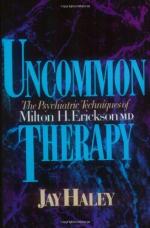
|
| Name: _________________________ | Period: ___________________ |
This test consists of 15 multiple choice questions and 5 short answer questions.
Multiple Choice Questions
1. When children have left home and can no longer "be used to ___________," the parents are often confronted with each other in a different way.
(a) "Communicate with siblings".
(b) "Facilitate the family unit".
(c) "Communicate between the parents".
(d) "Facilitate domination".
2. Eventually, through a lengthy process including both success and failure, Erickson gets Harold to complete what?
(a) High school.
(b) Military enrollment.
(c) Trade school.
(d) Grade school.
3. Which technique is also part of intentional hypnotic conditioning (here it is observed that uniformly siding with one family member and the creating of factions by the therapist is discouraged)?
(a) "Avoiding Self-Exploration".
(b) "Encouraging Resistance".
(c) "Amnesia and Control of Information".
(d) "Emphasizing the Positive".
4. Under which heading of Chapter 2 does Haley state that children develop their own roles within families and parents face serious changes when they leave?
(a) "Retirement and Old Age".
(b) "Breaking Apron Springs".
(c) "Leaving the Nest".
(d) "Weaning Parents From Children".
5. Haley states in Chapter 2, there is a need for the ______ to make a major adjustment towards the relationship of another family member but also to another family.
(a) Entire family.
(b) Parents.
(c) Siblings.
(d) Friends.
6. Harold succeeds in cultivating a friendship with an unintelligent ______ man who has been highly effective at making the best of who he is.
(a) Educated.
(b) Wealthy.
(c) Handicapped.
(d) Fatherly.
7. The transition from being a child into being an adult involves ______ of the relational patterns between family members.
(a) Dismissal.
(b) Rearrangement.
(c) Removal.
(d) Manipulation.
8. Erickson writes of withholding and sharing information and of how he succeeds in curing a young woman of pain she experiences during ______.
(a) Menstruation.
(b) Intercourse.
(c) Marriage.
(d) Childbirth.
9. Which title from Chapter 1 is also used for negative reinforcement and as a means to redirect patients?
(a) "Emphasizing the Positive".
(b) "Encouraging Resistance".
(c) "Avoiding Self-Exploration".
(d) "Providing a Worse Alternative".
10. In Chapter 5, Haley shows how Erickson applied therapy when the challenge was to help new parents over into the ______ of being parents.
(a) Involvement.
(b) Regression.
(c) Evolution.
(d) Phase of life.
11. Haley writes of one case in which a woman was directly threatened with death by her husband over what?
(a) The gender of their baby.
(b) Her spending.
(c) Her family.
(d) Her infidelity.
12. Which technique is rooted in two ideas: that at least many unconscious motives are beneficial and that positive reinforcement is most effective in influencing behavior?
(a) "Encouraging Resistance".
(b) "Seeding Ideas".
(c) "Emphasizing the Positive".
(d) "Avoiding Self-Exploration".
13. Haley points out that Erickson had suffered from _____ twice and had been debilitated by it/them.
(a) Strokes.
(b) Polio.
(c) Nervous breakdowns.
(d) Heart attacks.
14. Once he overcomes the severe effects of the poverty of his childhood, Harold manages to develop a new habit of __________.
(a) Dressing himself well.
(b) Asking guests to his house.
(c) Working out.
(d) Going to nice dinners.
15. Family stress is most severe when someone is _________ (in) the family.
(a) Entering or leaving.
(b) Ill or hospitalized.
(c) Dying.
(d) Under the influence of drugs or alcohol.
Short Answer Questions
1. The presence of a child or children creates a variant of the _____, which only grows in complexity with the advent of additional children.
2. Hypnosis is described as a special way of _______.
3. The amnesia seems to be for the purpose of helping the clients themselves to be able to feel as if he has not done what?
4. There may be fears, insecurities and inadequacies involved, but Erickson is not so interested in these or in explaining all about the shortcomings to the client, but rather Erickson focuses on helping the client to work towards what?
5. Haley writes of a case in Chapter 5 in which a new mother was so distraught that she was hospitalized; the trouble was that in some cases, the receipt of treatment is used by others in the greater familial context as what?
|
This section contains 648 words (approx. 3 pages at 300 words per page) |

|




